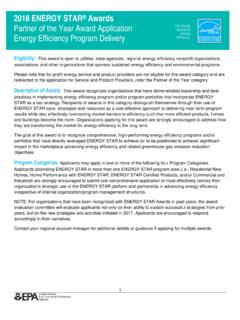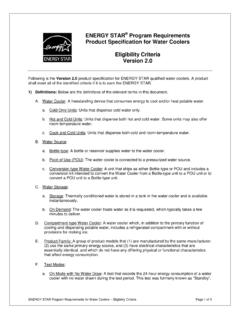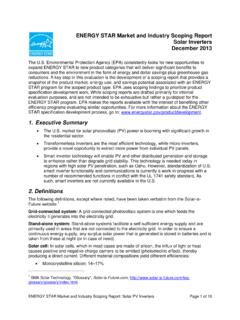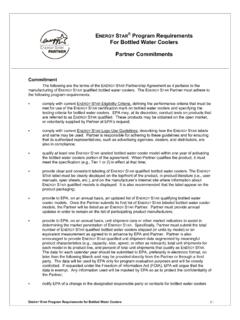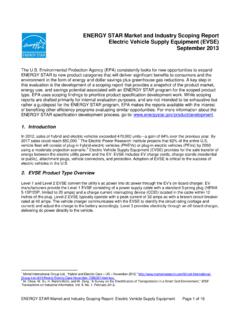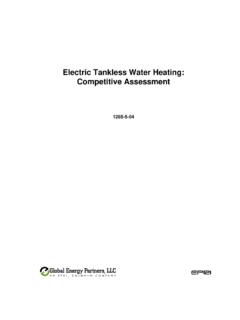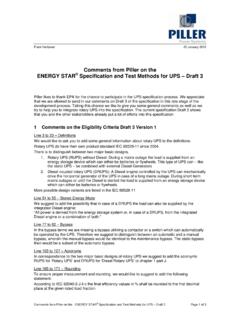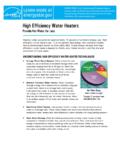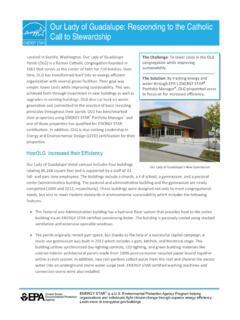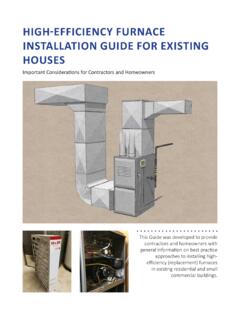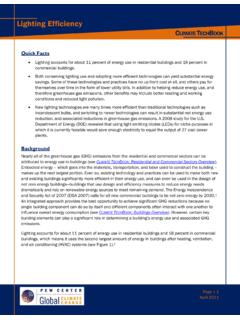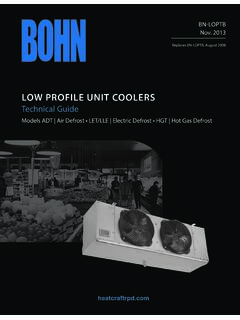Transcription of 11. Facility Type: Supermarkets and Grocery ... - Energy Star
1 Energy star Building Manual111. Facility Type: Supermarkets and Grocery StoresRevised January Challenges and Opportunities 2 Energy Use Profiles Technical Recommendations 4 Retrocommissioning 5 Lighting 8 Load Reductions 11 Air Distribution Systems 15 Heating and Cooling Systems Financial and Implementation Issues 17 Bibliography 17 Glossary G-1 Energy star Building Manual211. Facility Type: Supermarkets and Grocery Challenges and OpportunitiesEnergy is increasingly joining the ranks of top concerns for supermarket owners and Facility managers. Supermarkets are the most electricity-intensive type of commercial building, using an average of about 50 kilowatt-hours (kWh) of electricity.
2 They also use 50 cubic feet of natural gas per square foot (ft2) per year. At an average annual Energy cost of more than $4 per ft2, Energy expenses represent the most significant portion of the annual operating budget after labor costs for the Grocery retail sector. Because the profit margins of Supermarkets are so thin, on the order of 1 percent, the Environmental Protection Agency (EPA) estimates that $1 in Energy savings is equivalent to increasing sales by $ trends are pushing Grocery stores to become even more Energy intensive as stores are carrying more fresh-food products, frozen-food aisles are expanding, food-safety temperature requirements are tightening, and demand for prepared food is growing.
3 But this sector also offers some of the most cost-effective and rewarding opportunities for Energy sav-ings, not only by improving system efficiency and reducing unnecessary Energy use but also by reducing loads at peak times during the day, when Energy prices are highest. Here are the overall benefits that improved Energy efficiency can provide: Increased profitability. Energy savings are reflected in a company s profit-and-loss statement as reduced operating costs, which directly increase profitability. Total annual Energy costs to operate a supermarket are usually equivalent to net profit: Both are between 1 and 2 percent of sales.
4 Therefore, a 10 percent reduction in Energy costs can increase net profit by as much as 16 percent. For a major chain, efficiency improvements that cut Energy costs by 10 percent could yield tens of millions of dollars in added profit. Reduced vulnerability to Energy price fluctuations. Energy prices may be sensitive to numer-ous external factors, including major weather events and changes in national and state reg-ulations. For some regions, the potential for utility deregulation also lends uncertainty to future Energy costs. Reducing a Facility s total Energy consumption can soften the impact of Energy price fluctuations.
5 Increased sales. Improving the Energy efficiency of a building usually involves upgrades to the lighting and HVAC systems. By creating a more pleasing shopping and working envi-ronment, these upgrades can also attract and retain more customers, leading to an increase in sales. Reduced spoilage. Upgrades to refrigeration and lighting systems can reduce spoilage of perishable goods while also saving on Energy bills. Enhanced public image. With growing concerns over global warming and other environ-mental issues, many supermarket owners want to demonstrate to customers that they are responsible environmental stewards.
6 Supermarket owners can upgrade their buildings to be more Energy efficient as a way to achieve this goal. The impact of rising Energy costs and growing concerns about global warming are leading food sales organizations to take action. Hundreds of Grocery stores, including national and regional chain stores as well as independent grocers, are participating in the EPA s Energy star buildings program. For example, Hannaford Bros. Co. received national recognition as an Energy star Leader in 2006 by achieving an average Energy star Energy performance score of 75 or better across its portfolio of stores.
7 Hannaford also earned Energy star Energy star Building Manual311. Facility Type: Supermarkets and Grocery Storeslabels for 10 of its stores in Maine in 2007 by implementing upgrades and increasing Energy awareness among staff; its annual Energy savings is approximately $452,000. Hannaford is able to use Energy star s rating system not only to earn public accolades but also to compare its stores performance to that of similar stores nationwide and to track performance within the company s portfolio over Energy Use ProfilesWhen planning a retrofit strategy, consider a supermarket s largest Energy loads.
8 refrigeration is usually the largest electricity load in a supermarket, and space heating is by far the largest natural gas use (see Figure ). Energy intensity in Supermarkets varies widely and is correlated to gross square footage, quan-tity of refrigeration , and number of workers, although other variables, such as total weekly operating hours and the presence of an on-site kitchen or cooking area, can affect it as well. Energy intensity in Supermarkets ranges from less than 136,000 Btu/ft2 to over 278,000 Btu/ft2 (Figure , page 4). Given this wide range and skewed distribution, it can be misleading to assess a supermarket Facility s performance by looking only at its average Energy intensity.
9 The EPA s national Energy -performance rating system is designed to provide a meaningful benchmark for Supermarkets . The rating system is accessible online as part of the EPA s free Portfolio Manager tool ( ). It evaluates a supermarket s Energy intensity, normalizing for weather and operating characteristics. The rating is expressed as a score on a scale of 1 to 100, signifying the percentile of performance. Supermarkets that achieve a rating of 75 or higher are performing in the top quartile and may be eligible to earn Figure : Electric and natural gas end-use profile for Supermarkets Most of the electricity consumed by Supermarkets is used for refrigeration , and space heating typ-ically represents the largest use of natural gas.
10 Each Facility s Energy profile is different, however, so this chart is not representative of all supermarket buildings. Supermarket electricity use will vary depending on a store s gross square footage and total weekly operating hours, and Supermarkets with on-site cooking facilities might see higher levels of gas consumption for cooking. Courtesy: E SOURCE; from Commercial Building Energy Consumption Survey, 1999 dataPlug loads17%Cooling14% Refrigeration43%Lighting13% Other4% Ventilation4%Space heating2% Cooking2%Water heating1% Cooking13%Space heating74%Water heating13%ElectricNatural gasENERGY star Building Manual411.
